Good morning, sweeties! Happy Valentine’s Day!
I really wanted to send everyone a big bunch of exuberant roses for Valentine’s Day today!
But since it’s also Ash Wednesday, I was thinking maybe it was a good opportunity to share some ecclesiastical embroidery with you.
Wonder of wonders! It just so happened to work out that I could do both.
So here are your roses and your ecclesiastical embroidery, all rolled into one neat package!
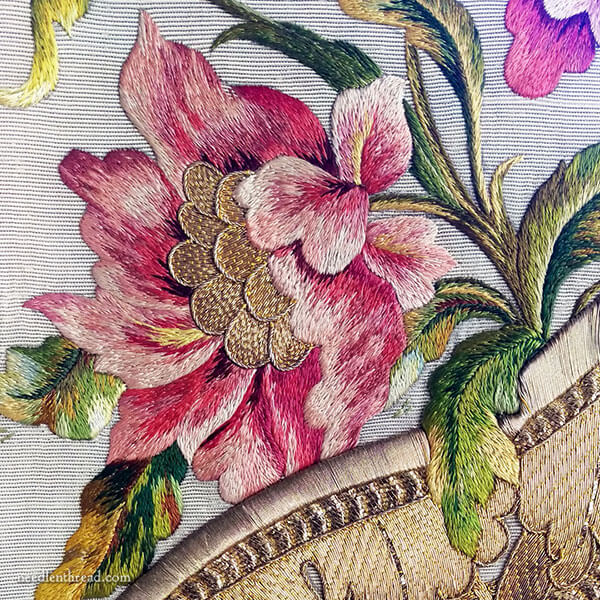
Needless to say, this is an old piece of ecclesiastical embroidery! They just don’t make them like this anymore. The embroidery on the vestment (the garb worn by a priest during the liturgy) is all worked by hand, and it is complete embroidery.
There’s no appliqué of fabric, there’s no paint over which some strokes of embroidery were added, in order to make it look like embroidery. No, no! On this piece, everything is totally embroidered, and it is embroidered with precision and skill.
These vestments come, absolutely, from the hands of masters of this type of embroidery.
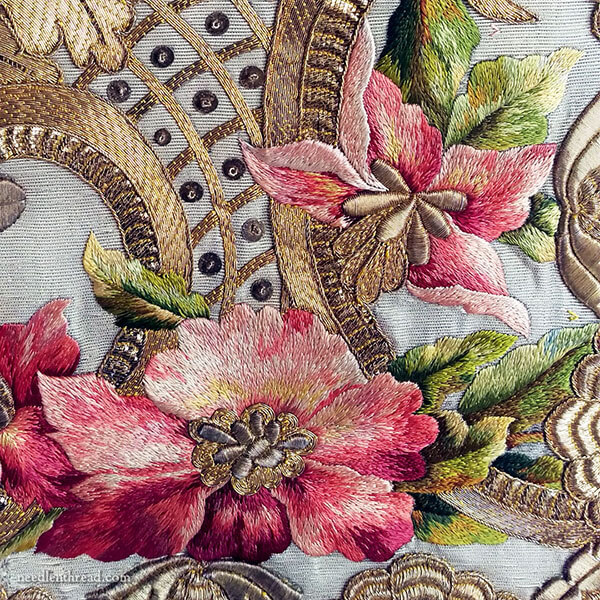
If I were trying to guess dates and provenances, by looking at the design, it would be hard to narrow down a date. The piece could be very, very old (late 1700’s / early 1800’s), moderately old (through the end of the 1800’s), or even relatively new (turn of the 20th century, at a stretch?).
They’re certainly European – I’m guessing they hail from either Spain, France, or Belgium.
They remind me of the embroidery done by the Visitation convents in France, which can still be seen at the Museum of the Visitation in Moulins. In fact, this is the cover of the book that I bought several years ago, cataloging the exhibits at the museum:
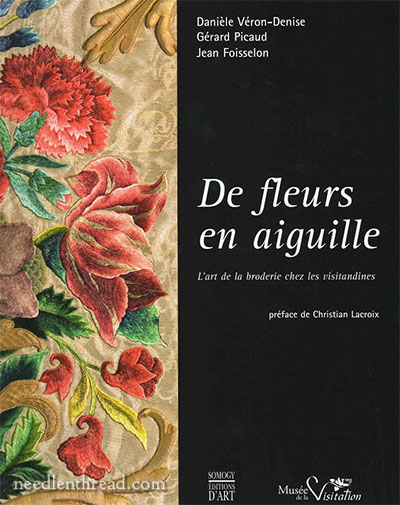
Within the book, there are many similar examples of exuberant florals on vestments, with goldwork. So…perhaps they hail from a Visitation convent.
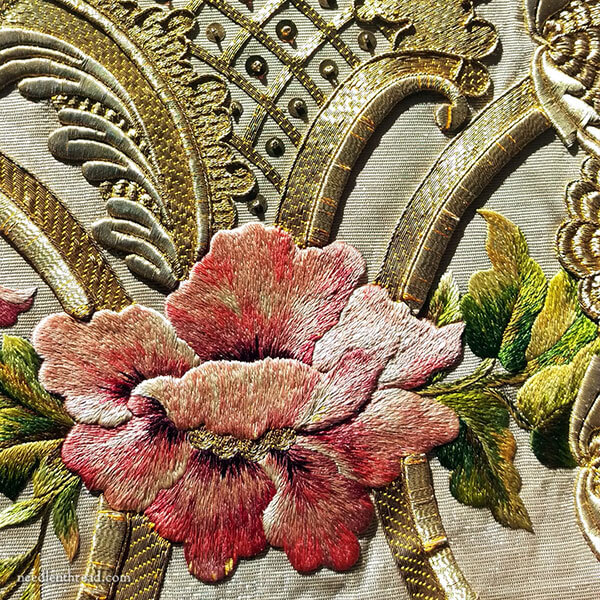
They’re in very good shape, though – not perfect shape, but good shape for their situation.
They’ve been carefully cared for, and they are still used, so I’d be more inclined to say they hail from a more recent era than from a more distant era.
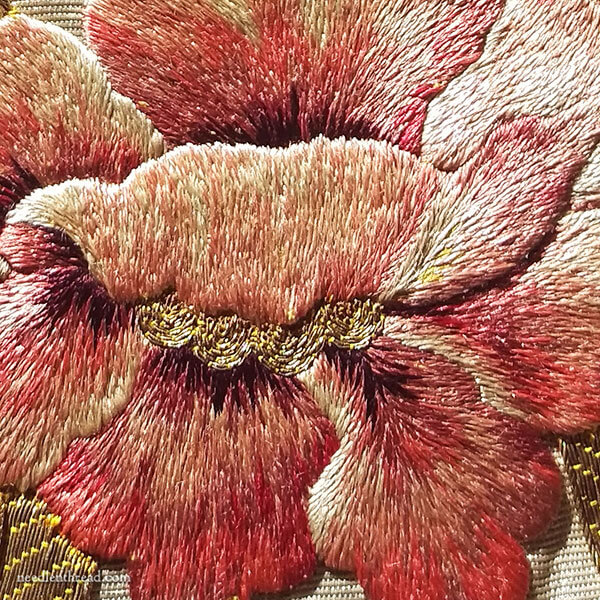
The silk shading is really exquisite. And the plethora of colors and shades of silk, among other things, indicates that this is no cheaply made vestment from a workhouse that cranked out ecclesiastical embellishments in assembly-line style, so that they could be appliquéd later onto the vestment ground fabric.
Rather, skilled embroiderers with access to a wide range of very good silk (it’s withstood the test of time amazingly!) sat down at a frame and worked individually on this piece of fabric, embroidering this design onto the ground fabric that makes the vestment.
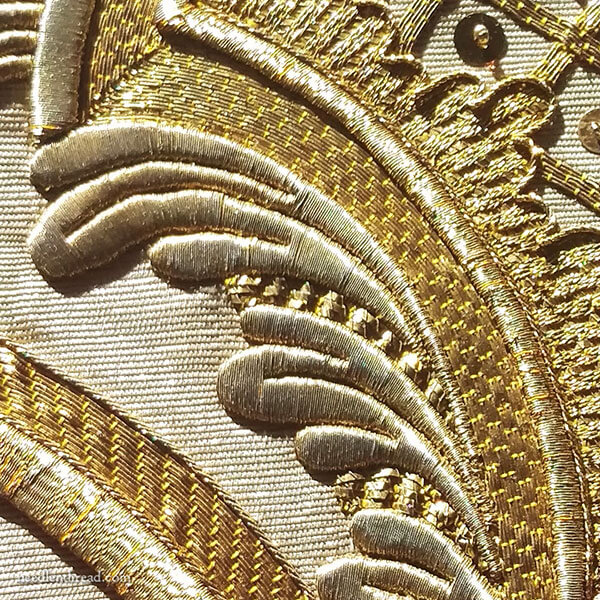
There is much intricate and exquisite goldwork, too, some over cards to give this really defined and chiseled look to the gold, some in regular laid work, some over string padding to give texture to the shapes (and to reflect the light), and lots of spangles (or paillettes), too – and, incredibly, very few are missing!
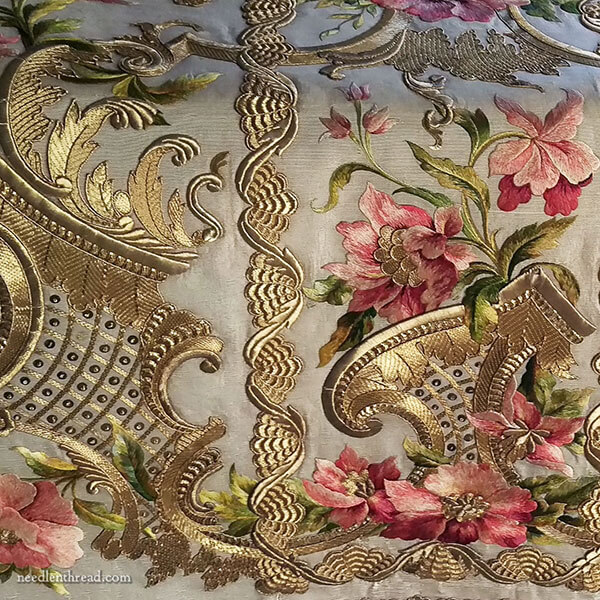
What a fabulous piece, don’t you think? Well cared for, still in use, and a clear tribute to the skill of embroidery artists in embroidery houses that produced exquisite pieces that could withstand the test of time so well.
Seeing pieces like this makes me wonder. I wonder about the hands that made it, the place it was made, the hearts of those who really put their heart and souls into this kind of art. The fact that it’s unsigned shows us that the glory wasn’t meant for them! I wonder about the threads they used – what did they feel like, how much brighter were they when this was new?
And then I wonder about this….
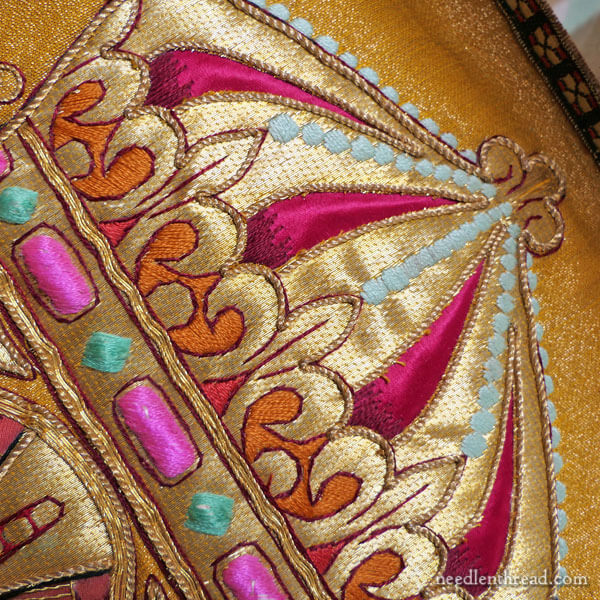
But this is a conversation for another day! It’s from a vestment that recently came my way, that has me befuddled and at the same time, amused.
I call it the circus vestment, though not with any disrespect towards its use. It’s just such a strange conglomeration of pieces and styles!
You can see here, though, the difference between a bespoke or commissioned piece (the rose vestment above was certainly a bespoke piece) and a vestment made through a workhouse, assembly line fashion.
And that, my friends, is your Valentine treat and an Ash Wednesday lesson in wonderment, all rolled into one.
Enjoy your day!







Dear Mary
Happy Valentine’s day to you what a stunning piece of work it is so beautiful all that gold work and beautifully embroided flowers and so old and still being used, wonderful. Yes I agree with you it would be really good to know who the embroiders were and how they made the piece. The book De Fleurs en aiguille looks really interesting and I suspect has some lovely embroidery pieces in it. Thanks for sharing with us the Valentine surprise and the lovely embroidery piece, I hope you have a lovely Valentine.
Regards Anita Simmance
Thanks, Anita!!
Wow, amazing, thanks for showing us.
Wow – the roses and goldwork are just stunning. The other one … leaves me speechless, but in rather a different way!
LOL! Exactly, Anne! It does the same to me. Speechless, with a bit of a question mark all over my face!
I’m wondering if the other one shows some influence from the Middle East or Asia . . . the choice of colors and shapes?
Strangely enough, some of the figures on that last one that I sneak peeked are somewhat Art Nouveau! More on that one later – and a comparison of two approaches to figures.
Breathtakingly beautiful. I would love to be able to stitch flowers like that. I love Goldwork too but I don’t think I would venture into that. Treat yourself to something nice for Valentine’s day.
Oh! Mary! This quite sets my heart pounding! This is as beautiful an embroidery as I have seen–I am already imagining getting my needle painting up to par and designing a piece from my favorite sections of this…oh for years enough and time! Truly motivating! Thank you so much for sharing this. (Heh heh, “circus” is exactly what came to my brain for the second piece, before I even read your thought on it—yikes! The contrast is rather a stitchy whiplash, “lol.”) But I will be spending a lot of time mooning over the floral vestment. Thank you for this glorious gift on this day of two kinds of ponderings.
Blessings,
Linda
I think this is the most beautiful piece of embroidery I have ever seen. Just stunning.
Adorei. A excelencia aqui apresentada por uma verdadeira MESTRE . Parabéns
Simply gorgeous! Thank you for sharing this amazing work of art with us!
As an embroiderer of religious items (scapulars and religious badges) I find embroidery a really nice opportunity to work and pray (when I can resist listening to audiobooks, that is 🙂
This embroidery is really magnificent, though, and must have taken such a long time to finish – months, I would think. The colors are so carefully chosen, and so much attention was given to texture and variety. I just finished a 40-hour commission, but I couldn’t even begin to make something this intricate and involving such a time-commitment.
It is an inspiration, as are all your posts!
I hope you have a happy Valentine’s day and a meditative Ash Wednesday (it’s tough that they are both on the same day, but at least it doesn’t happen very often!)
Thank you for sharing this beautiful piece of embroidery! And I can’t wait to see the other piece ;).
Magnificent! Thanks for sharing.
Wow! …. just WOW!
Have a great day Mary. Thanks so much for sharing.
Aw, geez, Mary! It’s Valentine’s Day, not April Fools! You led us down the primrose path to the full, sublime, gorgeous reveal of that exquisite piece and then…BOOM! Shudder. Like biting into an éclair that tastes like sour pickles! They say dark humor is a sign of intelligence, so…you’re a genius!
Happy Valentines Day, dear. Now, where’s the eye bleach?
Happy Valentines Day, to you, too, Mary. That is a stunning piece of work you shared with us today. Unbelievably stunning!! Thanks!
I really love this, truly very beautiful and romantic and the needlework is perfect, left me speechless. I think I am going to add to the list to learn to stitch this kind of embroidery. Thank you for the enabling.Happy Valentine’s day.
Mary, that is breathtakingingky exquisite embroidery. Do you have a picture of the entire piece? If so I would love to see it.
I agree with your opinion of the “circus” embroidery. I think it would be far preferable to have a very simple vestment than one done cheaply at a factory.
Hi, Mary! Thanks so much for sharing this post today. So, so beautiful…and the hours that go into the garments; a beautiful sacrifice and gift for sure. A friend of mine actually embroidered an epitaphios one year for Easter. It was so beautiful, and the fact that it will be used every year in church is so meaningful. It was a combination of appliqued, rich fabrics and embroidery (wish I had a picture of it!). Today is my birthday, which would be special enough, but the fact that it has fallen on Ash Wednesday (first time in 60 years) just thrills me. I’m much more excited about Ash Wednesday than my birthday! I’m one of those crazy people who actually looks forward to Lent every year…ha! Happy St. Valentine’s to you!
🙂 I do, too, actually!
I so enjoy needlenthread, Mary! I almost never comment, but enquiring minds want to know…what is the piece? A chasuble? A stole? It is hard to get an idea of the size! Could you share a photo of the whole vestment?
Hi, Katherine – it’s a chasuble. I don’t have a full photo of it, I’m afraid! It was draped over an ironing board (not for ironing, I’m sure!).
Whoa! Thank you so much for sharing this exquisite embroidery! Your photos are wonderful; I just want to reach out and pet it!
Wow! Just by pure luck I visited your blog today and here I see this unique, stunning and sublime piece of embroidery!
What a wonderful choice for Valentine’s day – Ash Wednesday gift 🙂
The second one, that looks like a crown, makes me think of Mardi Gras / Fasching / Fat Tuesday, of yesterday, that specific day of the year when everything’s supposed to be upside down 🙂
Anyway, you deserve a payback. So, I’m going to share one of my favorite Irish blessings, from an old Irish postcard, of my collection, stamped from 1918. I hope you like it:
“Happiness and Love Untold,
All the future for you hold.
Health and wealth and sweet content,
Be with Heaven’s blessing sent.”
Thanks, Rita!
Absolutely stunning. The gold work, the textures, the shading, everything about it is exquisite. Mary, you say this item is still in use — do you know where the vestment is?
Hi, Rosie – It’s at a Benedictine monastery in New Mexico.
Thank you for sharing with us these amazing photos. I just imagined a bishop with such a chasuble and cope, deacon or two with the dalmatics of the same style… And what if antepedium would be similar too? 😀 This would have looked stunning!
I often feel the same about handmade lace. The hands that held and worked the beautiful details. The woman who had other things to do in her busy life who took the time to create such beauty. What did she ponder or pray while creating a delicate piece? Was it a piece for herself, or maybe for her daughter’s trousseau?
Beautiful old textiles – so fragile, have such a mysterious history. I think that adds to the joy of collecting, and sometimes using them.
I really enjoyed this post – thank you!
Blessed Lent to you!
Grazie per tutti i bellissimi lavori che ci proponi.Ti seguo da sempre con ammirazione.Rosa Rimini ITALY
Thank you Mary! A wonderful Valentine’s gift. Lots of love back to you!
Greetings Mary! I hope this email finds you well!!! I’ve been trying to find sewing patterns for altar boy… Do you know where I can find them?
Thanks for your help!
Hi, Rosana – If you’re looking for a surplice pattern for altar servers, you can find them here, along with other vestment-related patterns: http://www.churchlinens.com/vestments/
is there anywhere in South Africa I will be able to by patterns for christening dress It is wow a dream, amazing that roses on the bonnet.
Just to say – thank you so much for all your mails, quite amazing. I am so envious of all the supplies you get as we, in good old South Africa, am finding it more and more difficult to get what we need in the embroidery world but we plod on!!!! Jan Brown
I keep finding your site from clicking on pictures all over the varies social media places they’ve been shared. I’m always directed back to this site and I LOVE it.
There’s so much info here. I’m very much a beginner, but I want to keep learning.
I have a question that maybe you can answer… I am planning on making a simple pall and I’m not sure if there is a particular fabric that the rubrics dictate must be used.. Like 100% linen. I’m not sure if there were changes made post v2, but I’m talking pre 1962 liturgical changes.
Thanks!
100% linen is the standard for a;l the small altar linens.
Hi, Gabrielle – The standard fabric for a pall used on the altar is linen. That said, the real requirement is that whatever touches or rests on the rim of the chalice is linen. So, technically, you can make a pall out of silk, and add a linen square backing to it, and that would suffice. But, considering that the pall is handled repeatedly, eventually, it will retain finger marks (soiling from natural oils on the hand) on the lower or middle of the right side of the pall, and the whole thing will need to be washed. This is easier done with a pall that’s made entirely of linen. And linen is a great ground fabric for embroidery, so there’s no reason why not to use it… although, if you’re planning to paint the design, some prefer to use silk rather than linen as the ground, and then they add the linen square on the back. If you’re looking for affordable ecclesiastical quality linen that makes nice small linens for the altar, try Church Linens and go for her 4.4/144 linen. If you have no budget limitations, then the “altar linen” that you can find at Needle in a Haystack is gorgeous – but it’s also $92/yard, as opposed to $35, like the linen at Church Linens.
SUPERBE BRODERIE quel bonheur de pouvoir admirer ce chef d’œuvre merci beaucoup
hail from France, Spain, Belgium…. OR HEAVEN!